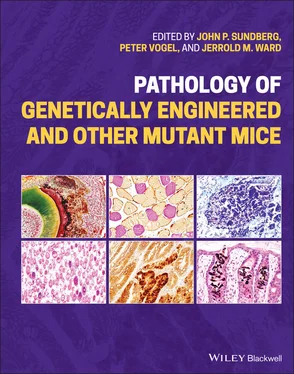Pathology of Genetically Engineered and Other Mutant Mice
Здесь есть возможность читать онлайн «Pathology of Genetically Engineered and Other Mutant Mice» — ознакомительный отрывок электронной книги совершенно бесплатно, а после прочтения отрывка купить полную версию. В некоторых случаях можно слушать аудио, скачать через торрент в формате fb2 и присутствует краткое содержание. Жанр: unrecognised, на английском языке. Описание произведения, (предисловие) а так же отзывы посетителей доступны на портале библиотеки ЛибКат.
- Название:Pathology of Genetically Engineered and Other Mutant Mice
- Автор:
- Жанр:
- Год:неизвестен
- ISBN:нет данных
- Рейтинг книги:3 / 5. Голосов: 1
-
Избранное:Добавить в избранное
- Отзывы:
-
Ваша оценка:
- 60
- 1
- 2
- 3
- 4
- 5
Pathology of Genetically Engineered and Other Mutant Mice: краткое содержание, описание и аннотация
Предлагаем к чтению аннотацию, описание, краткое содержание или предисловие (зависит от того, что написал сам автор книги «Pathology of Genetically Engineered and Other Mutant Mice»). Если вы не нашли необходимую информацию о книге — напишите в комментариях, мы постараемся отыскать её.
An updated and comprehensive reference to pathology in every organ system in genetically modified mice Pathology of Genetically Engineered and Other Mutant Mice
Pathology of Genetically Engineered and Other Mutant Mice
Pathology of Genetically Engineered and Other Mutant Mice — читать онлайн ознакомительный отрывок
Ниже представлен текст книги, разбитый по страницам. Система сохранения места последней прочитанной страницы, позволяет с удобством читать онлайн бесплатно книгу «Pathology of Genetically Engineered and Other Mutant Mice», без необходимости каждый раз заново искать на чём Вы остановились. Поставьте закладку, и сможете в любой момент перейти на страницу, на которой закончили чтение.
Интервал:
Закладка:
Skin Diseases: Skinbase (http://eulep.pdn.cam.ac.uk/~skinbase/index.php)
While there initially was a group that systematically reviewed skin, hair, and nails in KOMP mice [53, 69], this was discontinued. Some examples of skin phenotypes in mice with spontaneous single gene mutations are available as whole slide scans on Skinbase, a subdirectory of Pathbase ( http://www.pathbase.net). This site also has labeled images of normal skin, hair follicles, and nails to explain normal anatomy of these structures. Pathbase itself has thousands of tiff files on normal and abnormal examples in mice from wild type inbred strains to spontaneous single gene mutations in mice, to mutations caused by a variety of man‐made methods (radiation, chemical mutagenesis, and genetically engineered mice).
GenitoUrinary Development Molecular Anatomy Project (GUDMAP) ( https://www.gudmap.org)
GenitoUrinary Development Molecular Anatomy Project (GUDMAP) is a consortium of laboratories working to provide the scientific and medical community with tools to facilitate research on the GenitoUrinary (GU) tract. This resource is effectively a toolkit for the study of the mammalian urogenital system with a great deal of information on mouse mutants, tools, and strains. It presents a very significant educational resource for urogenital and prostate development, together with a collection of immunohistochemical, histological, and immunofluorescence images, and gene expression data for the mouse GU tract [70].
Mouse Brain Atlas ( https://developingmouse.brain‐map.org, https://mouse.brain‐map.org)
The mouse brain atlas is part of the Allen Brain Atlas project ( https://portal.brain‐map.org) and presents high‐resolution physical atlases of the adult and embryonic mouse brains based on histological sections annotated to gene expression at cellular resolution. The atlas has an interactive viewer with annotations based on a high‐resolution ontology for brain anatomy. There is also an atlas of the mouse spinal cord with an expression color map and serial histological sections. This is a powerful set of tools for the anatomy and molecular anatomy of the mouse brain and, for example, allows users to search for different anatomic regions with similar patterns of gene expression. There is related single cell data on morphology, gene expression, and single cell electrophysiology together with access to electrophysiological models. These data are all accessible through an API as well as a web interface [71].
Atlas of Mouse Cardiovascular Development ( https://www.devbio.pitt.edu/research/atlas‐mouse‐cardiovascular‐development)
This site presents a developmental atlas of the mouse cardiovascular system using episcopic fluorescence image capture (EFIC) imaging from E9.5 to term. Embryo sections are available in multiple orientations and can be viewed using a fly‐through interactive viewer. Some examples of EFIC 3D reconstructions are provided showing a variety of congenital cardiovascular anomalies seen in several knockout and ENU‐induced mouse mutants [72, 73].
Mouse/Human Disease Phenotype Databases
The connection between a mouse model and a corresponding human disease can be difficult to identify. MGI has multiple resources that allow for the identification of human disease models. MGD has the Human–Mouse: Disease Connection (HMDC) that enables searches for potential mouse models, candidate genes, and similarity between mouse models and human patients. Gene entries in MGD have links to predicted vertebrate orthologs in other species databases including Homologene, HGNC, OMIM, and Entrez Gene. MMHC contain tumor phenotypes from potential human disease models including human corresponding examples.
Online Mendelian Inheritance in Man (OMIM) ( https://www.ncbi.nlm.nih.gov/omim)
OMIM is a comprehensive database on human genes and genetic disorders and has been publicly available since 1987 [74]. OMIM is continually updated from the public literature and has links to other species databases. OMIM is the internet version of the multivolume book titled Mendelian Inheritance in Man by Victor McCusik [75] and is based at Johns Hopkins University. OMIM entries are classified using a standardized system of MIM numbers (denoting genetic classifications) and OMIM disorder codes (indicating loci associated genetic based diseases). OMIM concentrates on the genotype/phenotype relationship. OMIM entries contain text summaries of associated clinical features, molecular genetics, references, clinical synopses, phenotypic series the entry belongs to, and multiple graphic representations of the data [74]. Information and references on various animal models, including those in mice, that mimic or are confirmed orthologs is provided.
Emouseatlas ( https://www.emouseatlas.org/emap/home.html)
The Emouseatlas focuses on embryonic development of the laboratory mouse [76–81]. This website has four modules. EMA (Mouse Anatomy Atlas) covers mouse embryonic anatomy, ontology, and staging. Ehistology is an histology atlas of embryonic development that includes classic whole embryo images produced by Prof. Mathew Kaufman, used in his book Atlas of Mouse Development [82]. Emage covers mouse gene expression in embryos. Elearning provides tutorials to provide training on key principals of embryonic development.
Table 2.4 Sources of mouse models for human diseases.
| Vendor | Website address |
|---|---|
| Charles River Laboratory | https://www.criver.com/products‐services/find‐model |
| Envigo | https://www.envigo.com/p/research‐models/browse |
| Hilltop Lab Animals | http://hilltoplabs.com |
| Infrafrontier | https://www.infrafrontier.eu |
| Janvier Labs | https://www.janvier‐labs.com |
| Knockout Mouse Project (KOMP) Repository | https://www.komp.org |
| MRC Harwell Institute | https://www.har.mrc.ac.uk |
| Mutant Mouse Resource and Research Centers | https://www.mmrrc.org/catalog/StrainCatalogSearchForm.php |
| Simonsen Laboratories | http://www.simlab.com |
| The European Conditional Mouse Mutagenesis Program | https://www.mousephenotype.org/about‐impc/about‐ikmc/eucomm |
| The Jackson Laboratory | https://www.jax.org/mouse‐search |
| Taconic Biosciences | https://www.taconic.com/find‐your‐model |
Finding Mouse Models
While one can read a paper and contact the corresponding author to try to obtain mice to develop a colony for research, there are always concerns about real availability, time to get the mice, genetic quality (is the strain really what it is claimed to be?), pathogen status, and many other variables. Fortunately, a large number of commercial and nonprofit institutions have set up repositories to obtain, standardize, and distribute mice world‐wide. Some are listed in Table 2.4. Information provided on the websites can be quite detailed and specific while others can be limited to the degree that sometimes the specific mutation in the gene is not known. However, careful study of the literature provides a lot of the information needed to make an informed decision.
An alternative approach is to do your initial searches on MGI ( http://www.informatics.jax.org, described above). This website is not a mouse repository. However, if you look up your gene of interest (under the header Genes and then search for the gene of interest in the Genes and Marker Query) you end up at a Gene Detail page. On the lower right side is a category “All mutations and alleles” with a number. If you click on that (or the specific type listed below) you will get a listing of all published alleles with the correct (at the time of viewing) gene and allele symbol with a short summary. Click on the link to the allele of interest and you will get more information on that allele. At the bottom of the page, just above the reference list, is a section “Find Mice IMSR”. Click on that link and it will take you to the International Mouse Strain Resource (IMSR) or you can go to their site directly from the start ( http://www.findmice.org). This will tell you where in the world the mice are currently available from.
Читать дальшеИнтервал:
Закладка:
Похожие книги на «Pathology of Genetically Engineered and Other Mutant Mice»
Представляем Вашему вниманию похожие книги на «Pathology of Genetically Engineered and Other Mutant Mice» списком для выбора. Мы отобрали схожую по названию и смыслу литературу в надежде предоставить читателям больше вариантов отыскать новые, интересные, ещё непрочитанные произведения.
Обсуждение, отзывы о книге «Pathology of Genetically Engineered and Other Mutant Mice» и просто собственные мнения читателей. Оставьте ваши комментарии, напишите, что Вы думаете о произведении, его смысле или главных героях. Укажите что конкретно понравилось, а что нет, и почему Вы так считаете.












